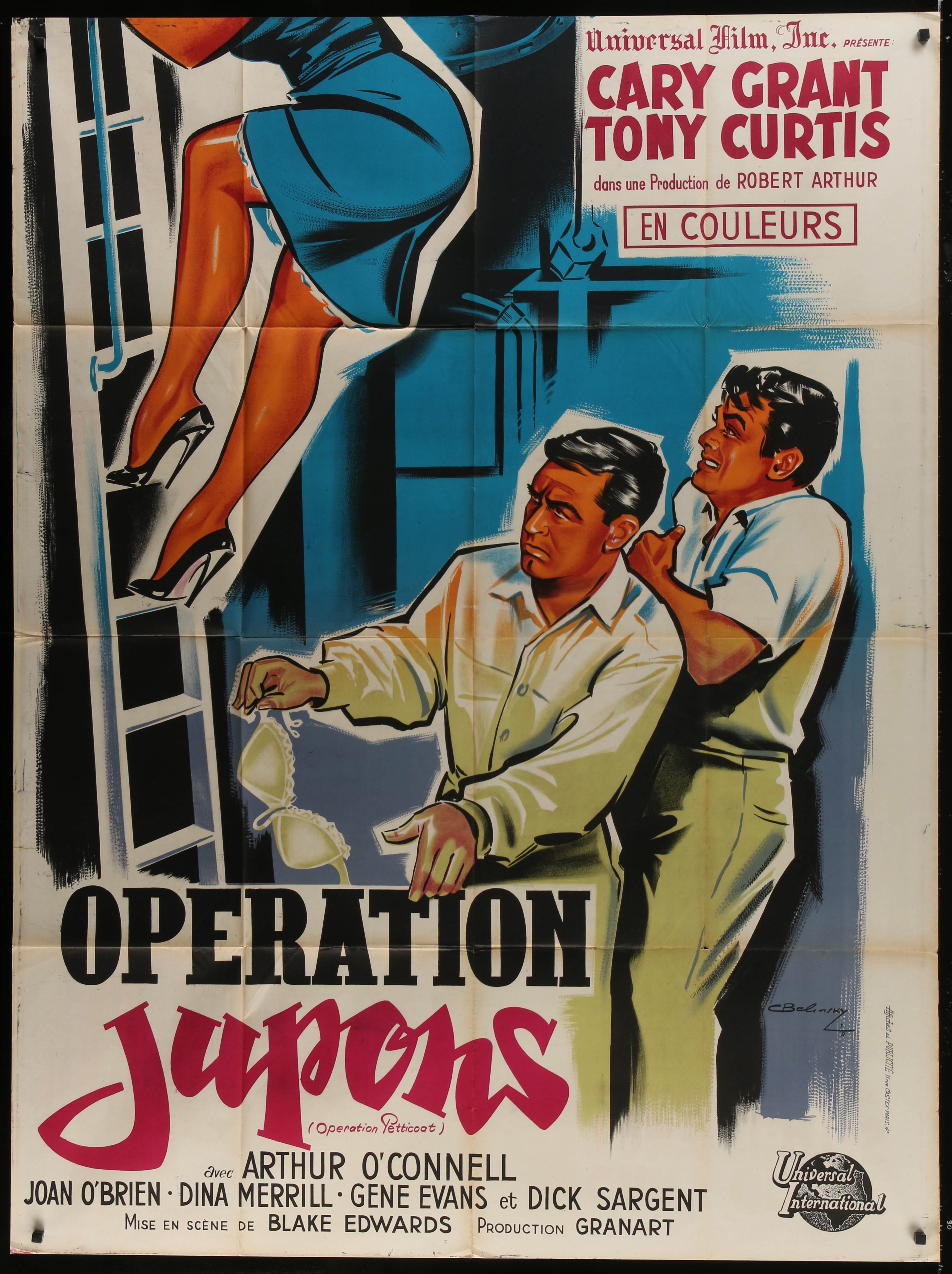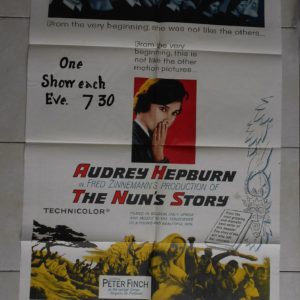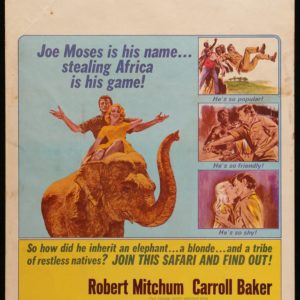Description
Original 1959 French large, used, folded (120 x 160 cm)
Operation Petticoat is a 1959 American World War II submarine comedy film in Eastmancolor from Universal-International, produced by Robert Arthur, directed by Blake Edwards, that stars Cary Grant and Tony Curtis.
The film tells in flashback the misadventures of the fictional U.S. Navy submarine, USS Sea Tiger, during the Battle of the Philippines in the opening days of the United States involvement in World War II. Some elements of the screenplay were taken from actual incidents that happened with some of the Pacific Fleet’s submarines during the war. Other members of the cast include several actors who went on to become television stars in the 1960s and 1970s: Gavin MacLeod of The Love Boat and McHale’s Navy, Marion Ross of Happy Days, and Dick Sargent of Bewitched.
Paul King, Joseph Stone, Stanley Shapiro, and Maurice Richlin were nominated for the Academy Award for Best Writing for their work on Operation Petticoat. The film was the basis for a TV series in 1977 starring John Astin in Grant’s role.
Plot
In 1959, U. S. Navy Rear Admiral Matt Sherman (Cary Grant), ComSubPac, boards the obsolete submarine USS Sea Tiger, prior to her departure for the scrapyard. Sherman, a plankowner and her first commanding officer, begins reading his wartime personal logbook, recalling earlier events.
On December 10, 1941, a Japanese air raid sinks Sea Tiger while docked at the Cavite Navy Yard in the Philippines. Lieutenant Commander Sherman and his crew begin repairs, hoping to sail for Darwin, Australia before the Japanese overrun the port. Believing there is no chance of repairing the submarine, the squadron commodore transfers most of Sherman’s crew to other boats, but promises Sherman that he will have first call on any available replacements. Lieutenant (junior grade) Nick Holden (Tony Curtis), an admiral’s aide, is reassigned to Sea Tiger despite lacking any submarine training or experience.
Holden demonstrates great skill as a scrounger after Sherman makes him the supply officer. He teams up with Marine Sergeant Ramon Gallardo, an escaped prisoner (he was caught misappropriating Navy property to run his own restaurant in Manila), to obtain materials desperately needed for repairs, persuading the captain to sign on Ramon as the ship’s cook. What Holden and his men cannot acquire from base warehouses, they “midnight requisition” from various military and civilian sources.
Refloated and restored to barely seaworthy condition, with only one of her four diesel engines operable, Sea Tiger puts to sea after a native Witch Doctor performs a protection spell for the voyage. Chief Motor Machinist Mate Tostin (Arthur O’Connell) had previously confided to Sherman that they’ve got No. 1 engine, he’ll answer for No. 2 when it is back together, and that he has been stripping parts from Nos. 3 and 4 to get Nos. 1 and 2 going. No. 1 does run, but is prone to backfiring and belching smoke.
Sea Tiger reaches Marinduque, where Sherman reluctantly agrees to evacuate five stranded female Army nurses. Holden is attracted to Second Lieutenant Barbara Duran (Dina Merrill), while Sherman has a series of embarrassing encounters with the well-endowed and clumsy Second Lieutenant Dolores Crandall (Joan O’Brien). Later, when Sherman prepares to attack an enemy oiler moored to a pier, Crandall accidentally hits the “fire” button before the Torpedo Data Computer has transmitted all the settings to the torpedo. It misses the tanker and instead “sinks” a truck ashore. Sea Tiger flees amidst a hail of shellfire.
USS Balao standing in for Operation Petticoat’s fictional USS Sea Tiger. A (scripted) belch of smoke from the troublesome No. 1 engine can be seen off the starboard quarter.
Sherman tries to put the nurses ashore at Cebu, but the Army refuses to accept them without the proper orders, as the Japanese are closing in. Unable to obtain needed supplies from official sources, Sherman allows Holden to set up a casino in order to acquire them from the soldiers who have taken everything useful into the hills for resistance use. Chief Torpedoman Molumphry has been asking for paint. Holden manages to get some red and white lead primer paint, but does not have enough of either to prime the entire hull. The two are mixed together, resulting in a pale pink primer that the chief reluctantly has applied. A Japanese air raid forces a hasty departure before the crew can apply the top coat of navy gray.
Tokyo Rose mocks the mysterious pink submarine, while the U.S. Navy believes it to be a Japanese deception, ordering that it be sunk on sight. An American destroyer spots Sea Tiger and opens fire, then launches depth charges when the submarine crash dives. Sherman tries an oil slick and then launches blankets, pillows, and life jackets, but the deception fails. At Holden’s suggestion, Sherman ejects the nurses’ lingerie. Crandall’s bra convinces the destroyer’s captain that “the Japanese have nothing like this”, and he ceases fire. Sea Tiger, still painted pink, arrives at Darwin battered but under her own power.
Sherman’s reminiscence ends with the arrival of Sea Tiger’s Commanding Officer, Commander Nick Holden, his wife (the former Lieutenant Duran), and their two sons. Sherman promises Holden command of a new nuclear-powered submarine, named Sea Tiger. Sherman’s wife (the former Lieutenant Crandall) arrives late with their four daughters and rear-ends her husband’s staff car, causing it to lock bumpers with a Navy bus. When it drives away, dragging his car with it, Sherman reassures his wife that it will be stopped at the main gate. Commander Holden takes Sea Tiger out, and her final departure is punctuated by a backfire and belch of smoke from the No. 1 diesel engine, still troublesome after all these years.
Cast
Cary Grant as Lieutenant Commander (later Rear Admiral) Matthew T. “Matt” Sherman, USN
Tony Curtis as Lieutenant, Junior Grade (later Commander) Nicholas “Nick” Holden, USNR (later USN)
Joan O’Brien as Second Lieutenant Dolores Crandall, NC, USAR
Dina Merrill as Second Lieutenant Barbara Duran, NC, USAR
Gene Evans as Chief Torpedoman “Mo” Molumphry, USN, Chief of the Boat of the Sea Tiger
Dick Sargent as Ensign Stovall, USN (billed as Richard Sargent)
Arthur O’Connell as Chief Motor Machinist’s Mate Sam Tostin, USN
Virginia Gregg as Major Edna Heywood, NC, US Army
Robert F. Simon as Captain J.B. Henderson, USN
Robert Gist as Lieutenant Watson, USN, Sherman’s Executive Officer (XO)
Gavin MacLeod as Yeoman Ernest Hunkle, USN
George Dunn as The Prophet (of Doom)
Dick Crockett as Petty Officer Harmon, USN
Madlyn Rhue as Second Lieutenant Reid, NC, USAR
Marion Ross as Second Lieutenant Colfax, NC, USAR
Clarence Lung as Sergeant Ramon Gallardo, USMC (billed as Clarence E. Lung)
Frankie Darro as Pharmacist’s Mate 3rd Class Dooley, USN
Tony Pastor, Jr. as Fox
Robert F. Hoy as Reiner
Nicky Blair as Seaman Kraus
John W. Morley as Williams
Ray Austin as Seaman Austin
Production
Curtis took credit for the inception of Operation Petticoat. He had joined the U.S. Navy during World War II with the intent of entering the submarine service in part because his hero, Cary Grant, had appeared in Destination Tokyo (1943). After he became a star, Curtis suggested making a film in which Grant would stare into a periscope as he did in Destination Tokyo. Curtis very much enjoyed working with Grant.
Former Universal-International contract star Jeff Chandler was originally set to have played Matt Sherman, but pulled out to film The Jayhawkers (1959) instead. Tina Louise turned down the role of one of the nurses as she felt the film had too many sex jokes.
Operation Petticoat was produced with extensive support of the Department of Defense and the US Navy. Most of the filming was done in and around Naval Station Key West, now the Truman Annex of Naval Air Station Key West, Florida, which substituted for the Philippines and Australia. Filming for the period suggesting postwar 1959 was done at Naval Station San Diego, California.
USS Sea Tiger was portrayed by three different American World War II Balao-class submarines:
USS Queenfish, in the opening and closing scenes (circa 1959), in which the “393” on the conning tower is visible;
USS Archerfish, for all the World War II scenes where the boat was painted the standard gray and black;
USS Balao, for all the scenes in which Sea Tiger was painted pink.
The attacking destroyer and, during the arrival at Darwin, the destroyer visible in the background are the USS Wren (DD-568).
Historical accuracy
A plot error says that Sea Tiger is heading to Darwin to meet up with the sub tender USS Bushnell in December 1941; Bushnell was not commissioned until 1943.
Some of the plot points of Operation Petticoat were based on real-life incidents, such as:
The evacuation of one Navy nurse and several Army nurses from Corregidor to Australia by the submarine USS Spearfish;[Note 2]
The sinking of the submarine USS Sealion at the pier at Cavite Navy Yard in the Philippines;[5]
The torpedoing of a bus by the USS Bowfin;[Note 3]
Captain Sherman’s letter to the supply department at Cavite on the inexplicable lack of toilet paper (based on an actual letter to the supply department of Mare Island Naval Shipyard by Lieutenant Commander James Wiggins “Red” Coe of the submarine USS Skipjack);[6][7]
The need to paint a submarine pink because of a lack of enough red or white lead undercoat: Heat from the burning USS Sealion also scorched off the black paint on the nearby USS Seadragon; for a time, the submarine fought with only her red lead undercoat visible. This led Tokyo Rose to disparage American “red pirate submarines”.
Another possible source for the “pink” submarine is the decorated USS Harder, commanded by Samuel David Dealey. Under the belief that a pinkish tint would help with camouflage, especially near dawn and dusk, Dealey added pink to the light grey that was standard for the Navy’s Measure 32 paint scheme.
Reception
Operation Petticoat was a hit with audiences and critics. The review in Variety was typical: “Operation Petticoat has no more weight than a sackful of feathers, but it has a lot of laughs. Cary Grant and Tony Curtis are excellent, and the film is directed by Blake Edwards with a slam-bang pace”. A much more restrained commentary came from Bosley Crowther of The New York Times, who noted in his December 8, 1959 review that the plot device of women aboard a wartime submarine was strained. “And that is the obvious complication upon which are pointedly based at least 60 per cent of the witticisms and sight gags in the film. How to berth the nurses in the exceedingly limited space, how to explain to them the functioning of the bathroom facilities, how to compel the sailors to keep their well-diverted minds on their work — these are the endless petty problems that vex Commander Grant”.
Box office performance
Operation Petticoat was a huge box office hit, making it the #3 moneymaker of 1960, earning $6,800,000. Operation Petticoat followed Alfred Hitchcock’s Psycho ($8,500,000) while the #1 film of 1960 was Ben-Hur ($17,300,000). For Grant, through his contract, his residuals topped $3 million, making Operation Petticoat his most profitable film to date.
1977 television series
The television cast: back, from left: Dorrie Thomson, Jamie Lee Curtis, Melinda Naud, Bond Gideon. Front, from left: Richard Gilliland, John Astin.
Operation Petticoat was adapted as an ABC-TV series which ran from September 17, 1977 to August 10, 1979. Initially starring John Astin in Grant’s role of Lieutenant Commander Sherman, the TV series cast Tony Curtis’ daughter, Jamie Lee Curtis, as Lieutenant Duran. Most of the cast was replaced for the show’s second season, a decision that led to low ratings and cancellation.[citation needed] Only 32 episodes of the series (22 in season 1, 10 in season 2) were produced in total.




